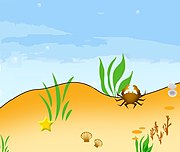
Back كائنات القاع Arabic Meiobenthos German Meiobentos Estonian میانزیاگان Persian Mejobentos Polish Мейобентос Russian
| Part of a series related to |
| Benthic life |
|---|
 |
|
Benthos Benthic zone Benthopelagic (coupling) Seabed |
Meiobenthos, also called meiofauna, are small benthic invertebrates that live in marine or freshwater environments, or both. The term meiofauna loosely defines a group of organisms by their size—larger than microfauna but smaller than macrofauna—rather than by their taxonomy. This fauna includes both animals that turn into macrofauna later in life, and those small enough to belong to the meiobenthos their entire life. In marine environments there can be thousands of individuals in 10 cubic centimeters of sediment, and counts animals like nematodes, copepods, rotifers, tardigrades and ostracods, but protists like ciliates and foraminifers within the size range of the meiobethos are also often included. In practice, the term usually includes organisms that can pass through a 1 mm mesh but are retained by a 45 μm mesh, though exact dimensions may vary.[1] Whether an organism will pass through a 1 mm mesh also depends upon whether it is alive or dead at the time of sorting.
The term meiobenthos was first coined in 1942 by Molly Mare, but organisms that fit into the modern meiofauna category have been studied since the 18th century.
© MMXXIII Rich X Search. We shall prevail. All rights reserved. Rich X Search